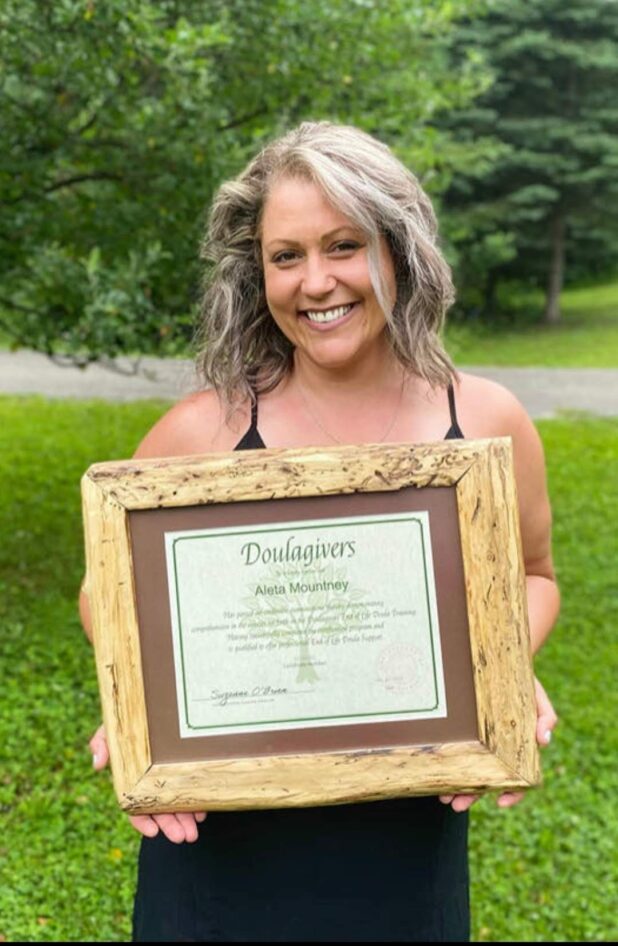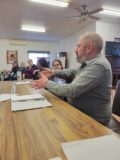General News
End of life doula discusses death
September 5, 2023

By Bill Kilpatrick
The British neurologist and writer Oliver Sacks once said, “It is the fate – the genetic and neural fate – of every human being to be a unique individual, to find their own path, to live their own life, to die their own death,” and as a “ThanaDoula” or end of life doula, Aleta Grace Mountney could not agree more… especially with the last part of the quote. A doula, according to Merriam Webster’s dictionary, is “ a person trained to provide advice, information, emotional support, and physical comfort to a mother before, during, and just after childbirth,” whereas an end of life doula, according to the Doulagivers Institute, is a “non-medical person who gives support physically, emotionally, and spiritually to someone else,” specifically the person who is dying and their loved ones.
End of life doulas, according to the Doulagivers Institute, are a “relatively new area of care” and for that reason there has been much misinformation propagated about who they are and what exactly they do. The misunderstandings have even led people to assume that Mountney is “into ‘hippy dippy voodoo,’” says Mountney, but she wants to clear the air so that people understand what she does and why she does it. “It started out that I lost my mother at 19,” says Mountney, “My parents didn’t shield me from that. I was exposed to death [at an early age].”
Mountney said that her first experience with death and what she called a “manifestation” occurred when she spent her 12 birthday in the Intensive Care Unit in Belleville Hospital where her uncle was dying. She described how her cousin along with other family members were waiting outside of her uncle’s room when they experienced an occurrence that cannot be explained. It was after hours, says Mountney, and all the doors were locked and her relatives were standing in the air conditioned hallway with red puffy faces due to their crying.
Mountney then goes on to describe how the family heard a “click-click,” which was the sound that her uncle’s door made when it was unlocked, and the family expected to see a doctor or janitor come through the door, but instead a woman dressed in a long red cloak and a red beret appeared. When the woman approached them and walked between them, according to her relatives, they felt a warmth go through them and they noticed that their faces were no longer puffy. When the family looked to see where the woman went, she had disappeared, and at that moment the nurse came out informing the family that their loved one has passed away.
Later when the family was looking through some old pictures, did those who were present at the death of her uncle recognize that the woman in red was their deceased great grandmother wearing the same outfit. “That was my first direct/indirect experience with death and then there was my grandfather, a close friend, and then it was one family member/family friend after another and then there was mom.”
“My mom was the only one that I was hands-on holding her when she died,” said Mountney, and it was this intimate encounter with death that led her on her current path. “When my mother took her last breath,” says Mountney, “It was the most incredible experience that I have ever experienced. It was like a lightening bolt of cotton candy. It just flashed through me, but it was like warm fuzzies at the same time. There’s no way to explain it. At that second I saw the white light and [my mother] was beaming… she was beaming. It was nothing but complete and utter serenity on her face and that was it. That was the moment that forever changed my path.”
Mountney then began a career as a nurse in long-term care homes which lasted for close to 20 years. She worked in both Ontario and out on the east coast and she observed that, “The clinical death as we see it these days, to me, is horrible,” said Mountney, adding, “This is why I went to the death doula. I want to help people take back their power. I want them to go on their terms,” regardless of what that looks like. Mountney described one patient who was palliative and actively dying and even though they were diabetic all they wanted was a cupcake, but the powers that be refused to give it to the dying individual. “I said to them, ‘Are you kidding me? What’s it going to do?’” It was incidents like this that drove Mountney to become a bit of a rule breaker who challenged some of the orthodoxy when it came to end of life care in long-term care homes.
Mountney described another incident with a man who had been palliative for over three years. He was extremely frail, according to Mountney, who said that “All he lived for was his cigarettes. He would come out he would have his smoke he would have his tea and he would go back to bed.” The man’s organs started to shut down on a Friday and he began the final stages of his journey. Mountney said goodbye assuming that he would pass on over the weekend, but to her surprise when she came back to work on Monday, he was still alive, so she went back to say her goodbyes for the second time. The man was unresponsive for three days and was expected to pass at any moment as his end-of-life fever had just broken, and even though he was not one of Mountney residents, she chose to go down and clean him up and put fresh linins on his bed.
The resident was facing the wall away from her and Mountney was talking to him the whole time, even though he was unresponsive, she asked him if he wanted to be on his stomach or his side, and to her surprise he turned over and put his fingers to his lips and made the smoking motion. Astounded, she then asked him if he wanted a cigarette and he made the motion again. Mountney then told him that she would sit him up and if he could hold himself up on the side of the bed, so that she knew it was physically safe to take him, she would put him in a wheelchair and steal some cigarettes for him. Again, to her surprise, he did it, but not only that, “He put himself in the wheelchair,” exclaimed Mountney. “It was January in Nove Scotia. I bundled him up with everything I could find. I stole a pack of cigarettes. I hauled him outside and he smoked one after the other for a good half an hour.”
The resident then asked for a cup of tea, which Mountney promptly got him. “He hadn’t eaten anything for three days. He had been unresponsive for three days,” Mountney said with amazement in her voice, but he managed to smoke a half a pack of cigarettes and drink a cup of tea. All of this, according to Mountney happened at around 4 p.m. and by 9 p.m. the resident took his last breath.
“That right there,” exclaimed Mountney, “Is what it’s all about. I don’t care that I broke the rules for him to go on his terms. That’s what the doula is to me, to make sure that people go on their terms.” Mountney made a promise to herself and others that “one day I will support people to transition on their terms in love, peace, and dignity intact without limits,” and now she is doing just that.
What exactly end of life doulas do and how they do it will be explored in part two of this article.
If anyone would like to find out more visit www.savinggracethanadoula.ca and message Mountney, or she can be reached by phone at 613-334-5059.


















